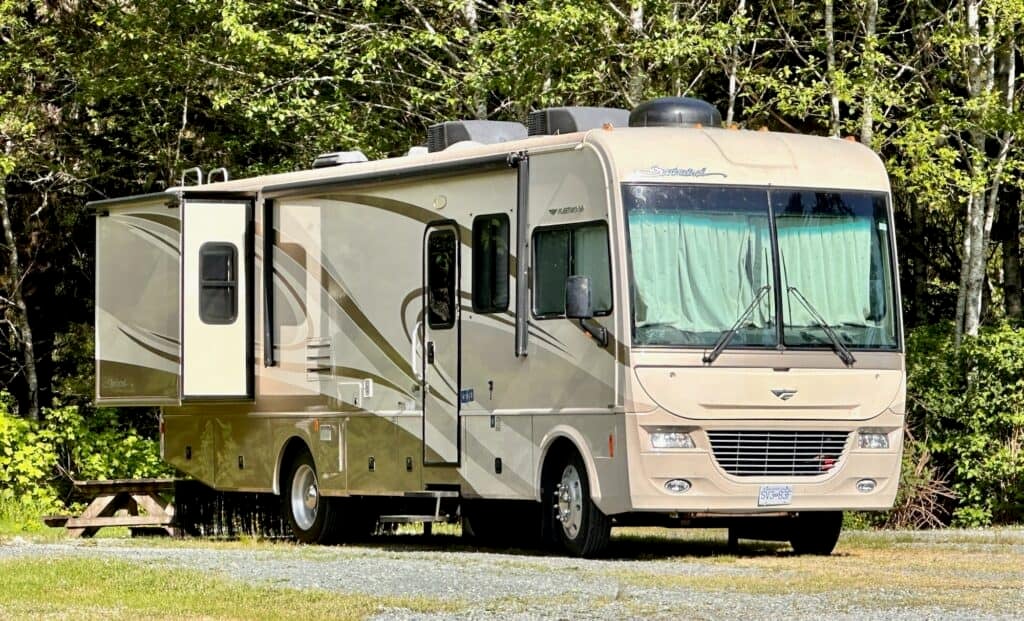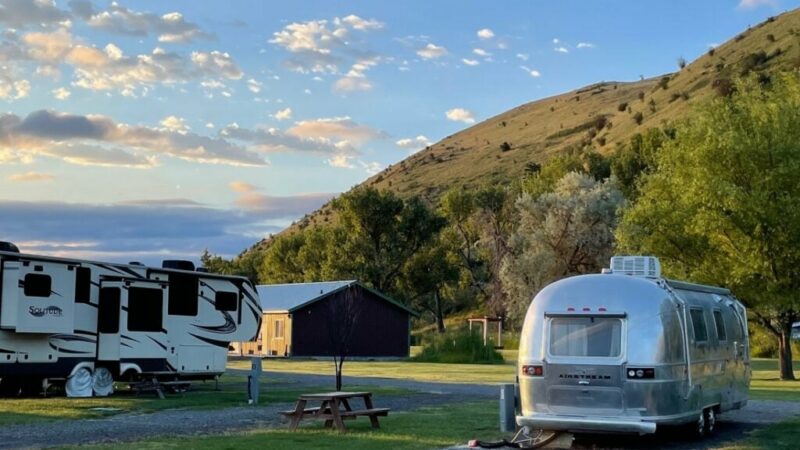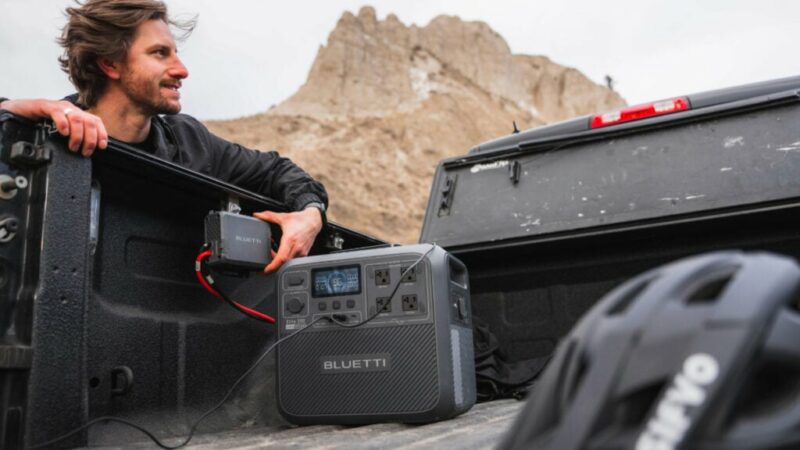What to Look for When Buying a Used Class A Motorhome
Why Buy a Class A Motorhome?
Do you want an RV that has lots of indoor living space, luxurious amenities, and plenty of storage? A perfect choice for road trips, Class A motorhomes offer all of these things and more. Class A motorhomes often offer sleeping space for 4–8 people and have more than enough cabinet storage for everyone’s gear.
Because the driving position is over the front wheels, behind a giant windshield, these RVs offer an unsurpassed driver and passenger experience. Not only that, but RV manufacturers ensure that the driver has everything right at hand for a nearly effortless driving experience. In this buying guide, I’ll walk you through everything you need to consider when you’re shopping for a used Class A motorhome.
For many people, the biggest pain point to buying a new Class A motorhome is the hefty price tag. A new Class A motorhome can cost anywhere between $265,000 for a Tiffin Open Road Allegro 32FA to about $2 million for a brand-new Prevost motorhome with all bells and whistles. With that said, buying a pre-owned Class A motorhome can save you a lot of money. Aside from spending less up front, there are a lot of other reasons to consider buying a used Class A motorhome. In this buying guide, we’ll take a look at everything you need to consider when you’re shopping for a used Class A motorhome.
Benefits of Buying a Used Class A Motorhome
One of the biggest benefits about buying a used Class A motorhome is that you can save a lot of money. Like other vehicles, they take the biggest depreciation hit when they’re first driven off the dealer’s lot. After that, depreciation eats away at the value at a slower rate. Buying a low mileage pre-2009 RV can get you a lot more bang for your buck than buying a new one. For one thing, most RVs come from the factory with at least one or two things that require fixing. A used RV will have had all the initial deficiencies repaired.
You’ll often find that these older RVs have high-end features and amenities as well as things like hardwood cabinets. And if something went wrong in the design and manufacturing process, it can sometimes be more obvious in a used RV than in a new one. In addition, the previous owners might have already done expensive upgrades to them so you won’t have to. For example, you might find they added solar panels or upgraded suspension components.
One thing to consider is that many used Class A motorhomes on the market have less than 50,000 miles on them. Some of these are luxury diesel pusher coaches (such as Country Coach, Beaver, Tiffin, etc.) that have beautiful features like hand crafted furniture and cabinetry. You can often find low-mileage diesel pusher motorcoaches for well under $150,000 on the RV Trader website.
Gasser or Diesel Pusher?
There are two basic types of Class A motorhomes: Gassers and diesel pushers. That said, gassers are Class A motorhomes that run on gas. They have a gas motor at the front of the RV beneath the cockpit area. They have an engine hood that makes it easy to check fluid levels etc, but the main access to the engine is through a doghouse that sits between the front seats. Gassers are often (but not always) smaller than diesel pushers. Another thing that distinguishes them is that many gassers don’t have a second axle (called a tag axle) located behind the drive axle. Most smaller gassers have more ground clearance than than large gas-powered RVs or diesel pushers. This is worth considering if you intend to use your RV for boondocking adventures.
Gasser Advantages
- Can be easier to drive
- Not having a tag axle means there are fewer wheels to maintain and tires to replace
- Many don’t have an air brake or tag axle, so CDL certification might not be necessary, depending on the RV floorplan
- The motor can be accessed without going into the bedroom
- A gas engine can be easier and cheaper to fix when something goes wrong.
- In some areas, it’s easier to find and access gasoline pumps than diesel, so you might have more route options with a gas powered Class A than a diesel pusher.
Gasser Disadvantages
- Class A motorhomes can’t carry as much as diesel pushers, so amenities and luxuries are often limited by their cargo carrying capacity. For instance, you won’t often find tile flooring in a typical gasser
- Can be noisy during travel due to the engine being located under the cockpit
- Don’t have as much towing capacity as a diesel
- May struggle on hills under load
- Pass-through storage compartments are interrupted by the drivetrain.
Diesel Pushers
Diesel pushers have a diesel-fueled engine mounted at the back of the RV. To help support this weight at the back of the RV, they often have a tag axle behind the drive axle. Diesel pushers are primarily longer than 30 feet, making them spacious, whether they have slideouts or not. The powertrains on diesel pushers make it possible for them to offer amenities like gleaming, hand tiled floors, high end furniture, and ceramic tile shower surrounds.
Diesel Pusher Advantages
- Very spacious because they’re usually longer and may have multiple slideouts
- Often have the most luxurious amenities because they have more space and higher cargo carrying capacity
- More powerful than a gasser with a much higher towing capacity, allowing you to bring more stuff and tow a bigger vehicle
- Diesel engines are known for durability and longevity
- Better fuel economy
- Higher resale value
- Quieter ride because the engine is at the back
Diesel Pusher Disadvantages
- Rear diesel engines can be difficult and time consuming to access when they need work done; this alone can make them more expensive to work on
- Larger desel pushers have a tag axle so there are more wheels and tires to maintain and replace. This can get very expensive
- Diesel fuel can be harder to find than gas and is usually priced higher
- A tag axle and air brakes likely mean you’ll need CDL certification to drive a diesel pusher
Shopping For a Used RV
Once you decide between a gasser and a diesel pusher, you’ll want to decide on an RV that fits your budget. You’ll want to narrow it down to a few different makes and models. Then find out what other RVers are saying about your chosen RVs in online RV owner groups like IRV2 forums. It’s also a good idea to have a look at at least a few floorplans before you decide on one that meets your needs. That’s because there are so many Class A motorhome floorplans available, there’s bound to be one that’s perfect for you. That said, some RV floorplans can look ideal for us in an online image but it often takes seeing them in person to appreciate whether they’ll work for us or not.
Where to Find a Good Used RV
There are now a few popular places online where you’ll find listings for RVs. These include:
- RV Trader
- Auto Trader
- Facebook Marketplace
- Craigslist
- Kijiji
Buying From a Dealer Versus Buying From a Private Party
Whether you buy your RV from an RV dealer or from a private party will be largely dictated by your budget and whether you need financing. While a private party can often offer a lower price, there are a few other things to consider. When you buy an RV from a dealer, they’ll often do whatever it takes to get an RV off their lot, including making any repairs that it needs—including replacement of aging tires or appliances. RV dealers are also usually happy to set you up with any RV financing you might need.
Here are a few things to be aware of:
- The dealer’s detailing department’s job is to make everything look shiny and new. They know RV buyers are attracted to shiny things, so they polish the RV until it looks brand new. A good detailer knows how to cover up or at least minimize the flaws that are inherent in a used RV.
- After researching RV models and floorplans, narrow the field down to a few RV models and/or floorplans you want to check out. Go to the dealership with a good idea what the normal asking price is for the RVs you are interested in.
- The RV sales associate’s job is to sell you an RV. That means they’ll do everything in their skillset to get you to purchase an RV. Their tactics often include creating a sense of urgency: ie Saying things like,”I have someone else interested in this RV” to expedite the sale. This will usually include telling you the RV you’re interested in has already been inspected. They might even produce a checklist of items that were inspected. Of course, everything will look peachy because they want you to feel confident the RV is in great shape.
- However, you should always insist on having a thorough independent inspection done on both the coach and the chassis. If the RV dealership won’t agree to these terms, assume it’s a sign that there’s something they’re hiding and walk away.
Mileage Considerations
Look for a motorhome with less than 80,000 miles for a diesel and less than 50,000 miles for a gasser. However, beware of mileage that seems excessively low for the age of the vehicle because motorhomes are built to move regularly. That means staying in one place without running the engine could result in seals drying out and other issues. In addition, tires on a motorhome that isn’t driven frequently will be subject to a condition known as “lot rot.” That term means they can deteriorate from the inside out. So they can look great on the outside, with no signs of wear while they deteriorate on the inside.
Check These Items Before You Hire an RV Inspector
A certified RV inspector has a trained eye for finding anything and everything wrong with an RV. However, RV inspectors aren’t cheap to hire. In light of that, it’s a good idea to inspect some items on the RV yourself. Here’s a checklist of things to check before you spend money on an RV inspection and/or a mechanical inspection.
Initial RV Inspection Checklist
If everything on the following list checks out, proceed to a certified inspection service:
- Low hours on the generator
- Body in good condition: No cracks, dents, or significant scratches
- Luggage compartments clean, not musty, no leaks
- Furniture and flooring in good shape
- Usability when the slideouts are in
- Solid-wood cabinets
- All appliances in working order (fans, air conditioners, refrigerator, microwave, etc.)
- Carefully check the roof and seals. The roof should look clean and sealant shouldn’t have cracking or gaps. Walk the roof and check for bubbles and soft spots which can both be signs of moisture intrusion
- Check inside for discoloration in the ceiling
- Use your nose: The interior should smell fresh, not musty or moldy
- Check the tires for wear. Excessive wear on inside or outside edges can indicate alignment issues. Check DOT stamp and make sure tires are less than 5 years old
- Use a flashlight to check ceiling inside cabinets for signs of moisture incursion such as discoloration, mold or dampness
- Ensure the solar array has proof of professional installation
- Window seals and exterior sealant in good condition
- Records of mechanical maintenance and repairs
- CARFAX shows no accidents
- No leaks under engine compartment
- RV drives smoothly, turns, and brakes with no issues.
Negotiate the Best Deal
After you receive the inspection reports for both the RV inspection and the mechanical inspection by a heavy-duty mechanic, it’s time negotiate a price. Note any work that needs to be done and research the cost of having it done. Subtract the total from the asking price, or get the dealer to do the work before you sign anything. This should give you a fair starting price. Be a fair negotiator, but be prepared to walk away.
Key Takeaways for Buying a Used Class A Motorhome
While this guide touches on the most important considerations for buying a used Class A motorhome, it’s by no means exhaustive. There are a lot of things to consider when choosing the perfect rig for your specific purposes. With that said, buying a used Class A motorhome offers a lot of valuable benefits that can get you a luxurious coach at a fraction of the cost of a new one. That said, many well-maintained older RVs still have many miles—and smiles—left in them.
The post What to Look for When Buying a Used Class A Motorhome appeared first on RV LIFE.
Source: https://rvlife.com/what-to-look-for-when-buying-a-used-class-a-motorhome/








